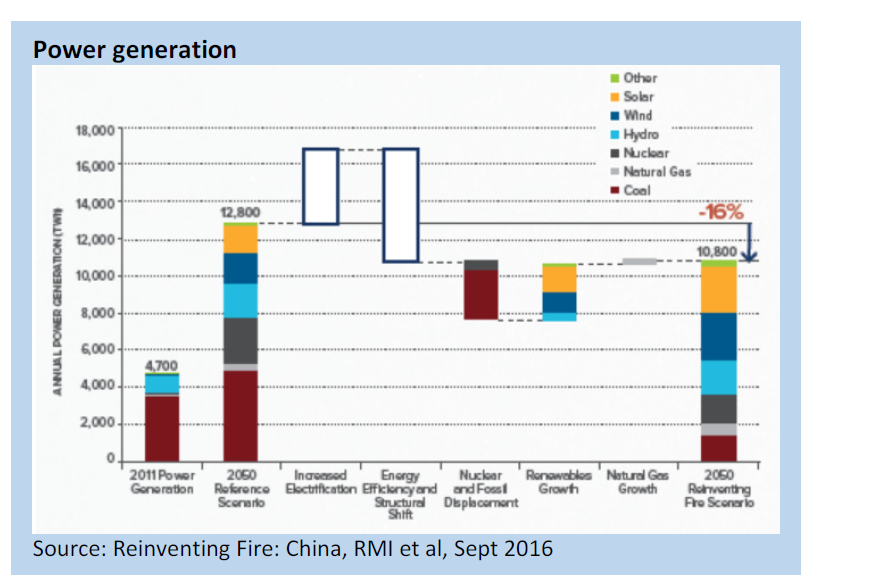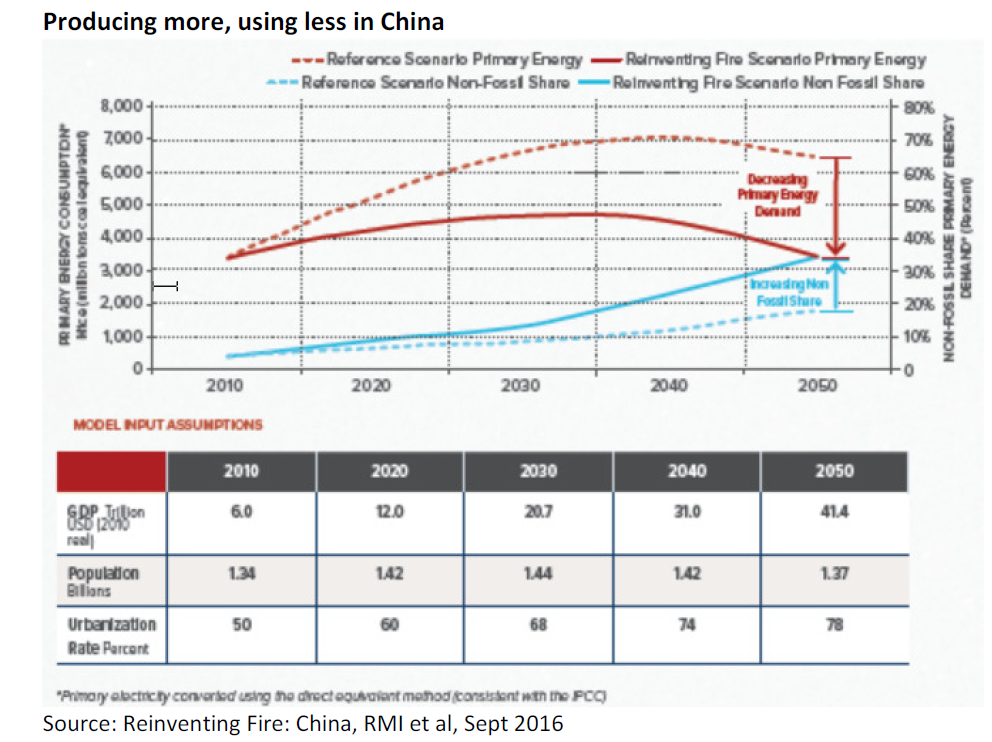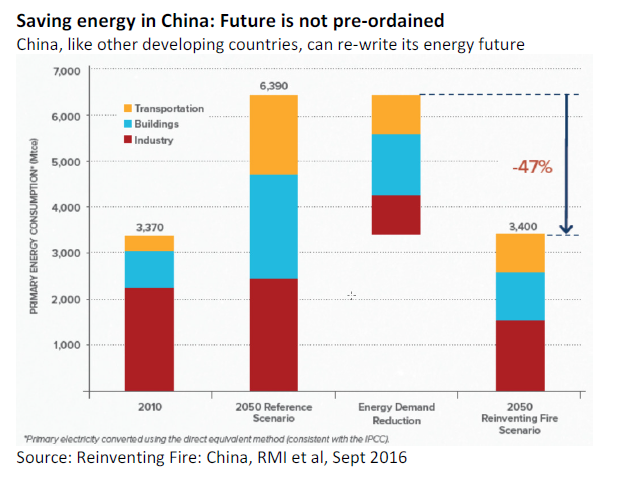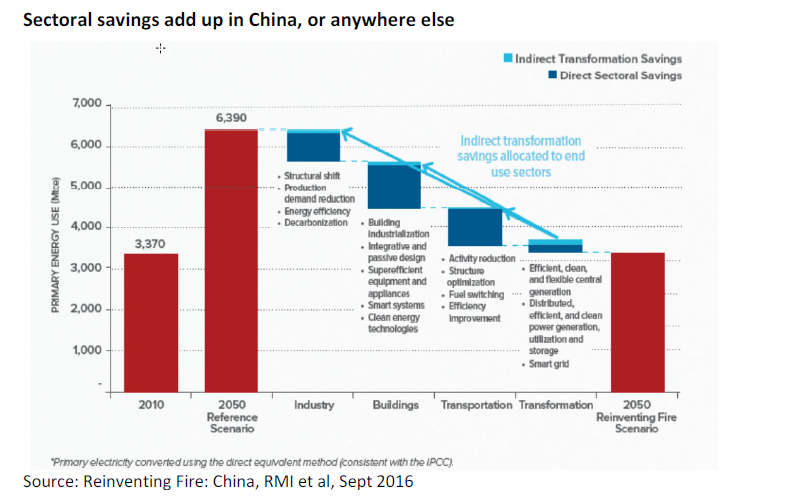Page added on November 21, 2016
Reinventing Fire in China

Amory Lovins’ Rocky Mountain Institute, backed by Chinese institutions and Lawrence Berkeley National Laboratory, has published a stunning roadmap for an energy revolution in China. If its ideas are taken up, it could lead to a transformation of the largest energy economy in the world – and serve as a model for other developing nations to follow, writes Fereidoon Sionshansi, president of Menlo Energy Economics and publisher of the newsletter EEnergy Informer.
In 2011, Amory Lovins and his colleagues at the Rocky Mountain Institute (RMI) published Reinventing Fire: Bold business solutions for the new energy era. As has been his style, and as suggested by the book’s subtitle, Lovins was bold in his assessment of how much – or in this case how little – energy will be needed to fuel US economy’s continued growth and prosperity while maintaining the American standard of living.
The book posed the following question: “Could the US realistically stop using oil and coal by 2050? And could such a vast transition towards efficient use and renewable energy led by business for durable advantage?”
Lovins’ answer – you guessed it – was a resounding yes to both.
The report proclaims that you can have your cake and eat it too: economic growth and prosperity can be sustained while using far less energy, emitting far less carbon, and generating far less waste and environmental damage
In the book’s preface, he wrote, “Imagine fuel without fear. No climate change. No oil spills, dead coal miners, dirty air, devastated lands, lost wildlife. No energy poverty. No oil-fed wars, tyrannies, or terrorist. Nothing to run out. Nothing to cut off. Nothing to worry about. Just energy abundance, benign and affordable, for all, forever.”
Almost poetic, fantastic, and too good to be true. It is classic Lovins. To make its points and support its conclusions, the book examines 4 major users of energy in the US, transportation, buildings, industry and electricity and shows how we can get by with less energy while transitioning to a cleaner, greener and more sustainable future. The most amazing thing about the book’s thesis is not only that it can be done, but the transition will in fact save us money.
As Lovins likes to remind us, energy efficiency is not just a free lunch, it is a lunch you are paid to eat.
Controversial
The 2011 book, like his 1976 Foreign Affairs article, is controversial. His supporters hailed it as the energy road map for the future while many in the fossil fuel industry, coal and oil dismissed it as fantasy or worse.
Fast forward to September 2016 and a new study called Reinventing Fire: China; A roadmap for China’s revolution in energy consumption and production to 2050. It is an attempt to do for China what was done for the US. The study is a collaboration of Energy Research Institute of the National Development and Reform Commission of China, RMI, Lawrence Berkeley National Laboratory (LBL) and Energy Foundation China. It took over 3 years with input of all these organizations.
Apparently the report has support among the highest levels of government in China, where vast resources are going into building a new energy infrastructure
Reinventing Fire: China is perhaps even more ambitious and bold than its US counterpart, partly because China is still a developing economy with vast growth aspirations, not just in terms of its economy but to uplift millions of people from poverty to middle class, manage the biggest migration of rural populations to cities, industrialization, while keeping its air clean, water drinkable and responding to the demands of its citizens, who aspire to enjoy high standards of living as in developed economies.
To start with, the report proclaims that you can have your cake and eat it too: economic growth and prosperity can be sustained while using far less energy, emitting far less carbon, and generating far less waste and environmental damage (graph 1).

Apparently the report has support among the highest levels of government in China, where vast resources are going into building a new energy infrastructure.
Fast growth trajectory
The report claims that China can get by with 47% less energy by 2050 compared to the so-called reference scenario – more or less a business-as-usual case (graph 2).

How can such a feat be accomplished? It is classic Lovins: you add up the savings from various sectors through an elaborate bottom-up analysis of how much energy can be saved from each sector of the economy (graph 3).

The starting point in each sector and for each end-use is to ask how can we best deliver the desired energy services at the least cost, tacitly including the cost of carbon emissions, water consumption, environmental degradation and so on in the process. Along the way, the report reshapes the industry, the transportation sector and buildings – why not? Every sector can be made far more efficient and more productive, while saving energy and money.
Since China is on a fast growth trajectory – adding infrastructure, buildings, factories, harbors, airports, ports, roads, power plants, you name it – it can select its development path and future destiny much faster and cheaper than mature economies where all infrastructure is already built and hard to replace. In the process, China’s overall energy consumption shrinks while it transforms from roughly 80% dependence on dirty fossil fuels to roughly 80% non-carbon emitting energy resources including nuclear by 2050.
The results of the study are short of stunning, especially in the electricity sector where consumption is projected to peak somewhere around 2040 with significant drop in greenhouse gas emissions compared to the reference case. China’s power generation mix is equally transformed along the way, not only using less primary energy but far more of it coming from non-carbon resources by 2050 (graph 4).

For the skeptics, the road map envisions China’s rapid transformation from a rural, developing economy to a largely urbanized advanced economy by 2050 in 3 phases from 2010-20, 2020 to 2030 and through 2050.
What is needed now is a repeat of the same exercise for India, Indonesia, Pakistan, Nigeria, Iran, Turkey, Saudi Arabia and numerous other populous and rapidly developing economies of the world so that they too can pursue a cleaner, greener and more sustainable growth trajectory rather than pursuing outdated policies of the past. Wouldn’t that make perfect sense, especially in view of COP21 targets? Like China, these countries are adding new infrastructure at a rapid pace. What better opportunity to get it right from the start, rather than build the wrong one, only to replace it again.
7 Comments on "Reinventing Fire in China"


rockman on Mon, 21st Nov 2016 3:26 pm
“…China’s rapid transformation from a rural, developing economy to a largely urbanized advanced economy…”. Which was exactly the process that led the US to become a tremendously disproportionate user of energy in the world. Will be great when therther Chinese do the same without using fossil fuels asdasd the US did. Thank goodness all the assumptions made in this model will prove true.
In the meantime the increase in demand for thermal coal after China curtailed production has allowed Australians to increase their export price from $55/ston to $100/ston.
penury on Mon, 21st Nov 2016 4:25 pm
To dream the impossible dream. I just hope that like most people he merely wrote what he was told to. Otherwise he will really be disappointed.
onlooker on Mon, 21st Nov 2016 5:59 pm
Such delusions of grandeur meanwhile the reality of a very overpopulated country, a everyday worsening Earth environment an Oil supply that is becoming less able to supply the planet with net energy, the limitations of renewable energy are lost to the hubris of modern man
makati1 on Mon, 21st Nov 2016 6:28 pm
When your income depends on your not seeing reality…
Jerry McManus on Mon, 21st Nov 2016 9:15 pm
Just seeing the name “Amory Lovins” makes me gag. He has been peddling his own peculiar brand of techno-porn for years now.
Every time for the last ten years that I have seen his “techno utopia for next to no energy” ejaculations I have always been struck with the same sticky question:
If it was so God Damn easy to live in “techno utopia for next to no energy” then why the Holy Living Hell haven’t we been doing it for at least the last 50 fucking years now?
What’s been stopping us?
Lovins and his ilk will never be able to answer that blindingly simple question, no mater how fast and furiously they stroke their engorged, um, ego.
Anonymous on Tue, 22nd Nov 2016 4:48 am
Good thing a bunch of dudes somewhere in the rocky mountains have come up with a plan for what CHINA should do. Im sure as soon as China hears about this made-in-the-rockies-plan, they will get right to work implementing it.
Shortend on Tue, 22nd Nov 2016 6:45 pm
Amory Lovins been around since way back circa 1980’s and even though the ideas are sound, we took BAU route ….the known easy way and gave future generations the finger….after all they have done nothing for us here today…LOL